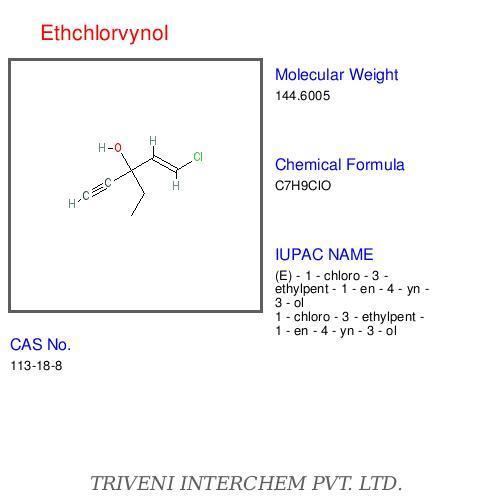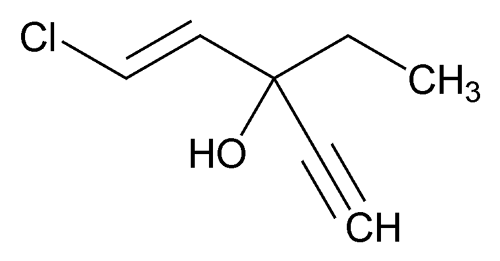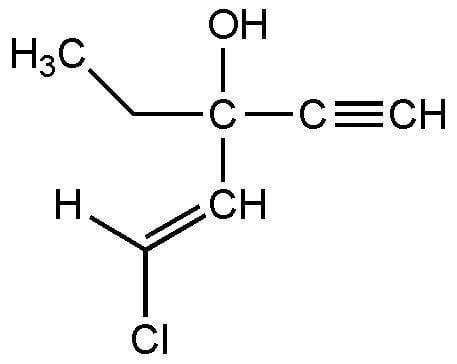Routes ofadministration Oral Protein binding 35–50% Molar mass 144.598 g/mol | ATC code N05CM08 (WHO) CAS Number 113-18-8 CAS ID 113-18-8 | |
 | ||
AHFS/Drugs.com Micromedex Detailed Consumer Information Legal status CA: Schedule IVDE: Anlage II (Prohibited)US: Schedule IV | ||
Ethchlorvynol/ˌɛθklɔːrˈvaɪnɒl/ is a sedative and hypnotic medication developed by Pfizer in the 1950s. In the United States it was sold by Abbott Laboratories under the tradename Placidyl. Placidyl was available in 200 mg., 500 mg., and 750 mg. strength capsules. While the 500 mg. and 750 mg. strength capsules were for use in reducing sleep latency, the 200 mg. strength capsules were intended to be used to re-induce sleep in case of early awakening. Abbott discontinued production in 1999, after which Placidyl was available for about a year in the United States. Although, theoretically, ethchlorvynol could be manufactured for sale in the United States by another pharmaceutical company (subject to FDA approval of such manufacture), no pharmaceutical company has chosen to do so. Individuals with a valid prescription for the substance may legally transport a reasonable amount of ethclorvynol with them into the United States.
Contents

Use and effects

Ethchlorvynol was used to treat insomnia, but prescriptions for the drug had fallen significantly by 1990, as other hypnotics that were considered safer (i.e., less likely to result in overdose) became much more common. It is no longer prescribed in the United States due to unavailability, but it is still available in some countries and would still be considered legal to possess and use with a valid prescription.

Along with expected sedative effects of relaxation and drowsiness, adverse reactions to ethchlorvynol include skin rash, faintness, restlessness and euphoria. Early adjustment side effects may include nausea and vomiting, numbness, blurred vision, stomach pains and temporary dizziness. Overdose may be marked by a variety of symptoms, including confusion, fever, peripheral numbness and weakness, reduced coordination and muscle control, slurred speech, reduced heartbeat, respiratory depression, and in extreme overdoses, coma and death.

Placidyl can be addictive. After prolonged use, withdrawal symptoms may include convulsions, hallucinations, and amnesia. As with most hypnotics, Placidyl was indicated for use in the treatment of insomnia for a short period of time (a week or two). However, it was nonetheless not uncommon for doctors to prescribe Placidyl (and other hypnotics) for extended periods of time.

During the late 1970s, ethchlorvynol was sometimes over-prescribed causing a minor epidemic of persons who quickly became addicted to this powerful drug. Occasional deaths would occur when addicted persons would try to inject the drug directly into a vein or an artery. Ethchlorvynol is not compatible with intravenous injection and serious injury (including the loss of limbs due to vascular injury) or death can occur when it is used in this manner.
Chemistry

Ethchlorvynol is a member of the class of sedative-hypnotic carbinols, which includes methylparafynol and tert-amyl alcohol. It is not a barbituric acid derivative. The systematic name of ethchlorvynol is usually given as ethyl 2-chlorovinyl ethynyl carbinol or 1-chloro-3-ethylpent-1-en-4-yn-3-ol. Its empirical formula is C7H9ClO.

Ethchlorvynol is synthesized by an ethynylation reaction using lithium acetylide and 1-chloro-1-penten-3-one in liquid ammonia, followed by acidic work-up.




